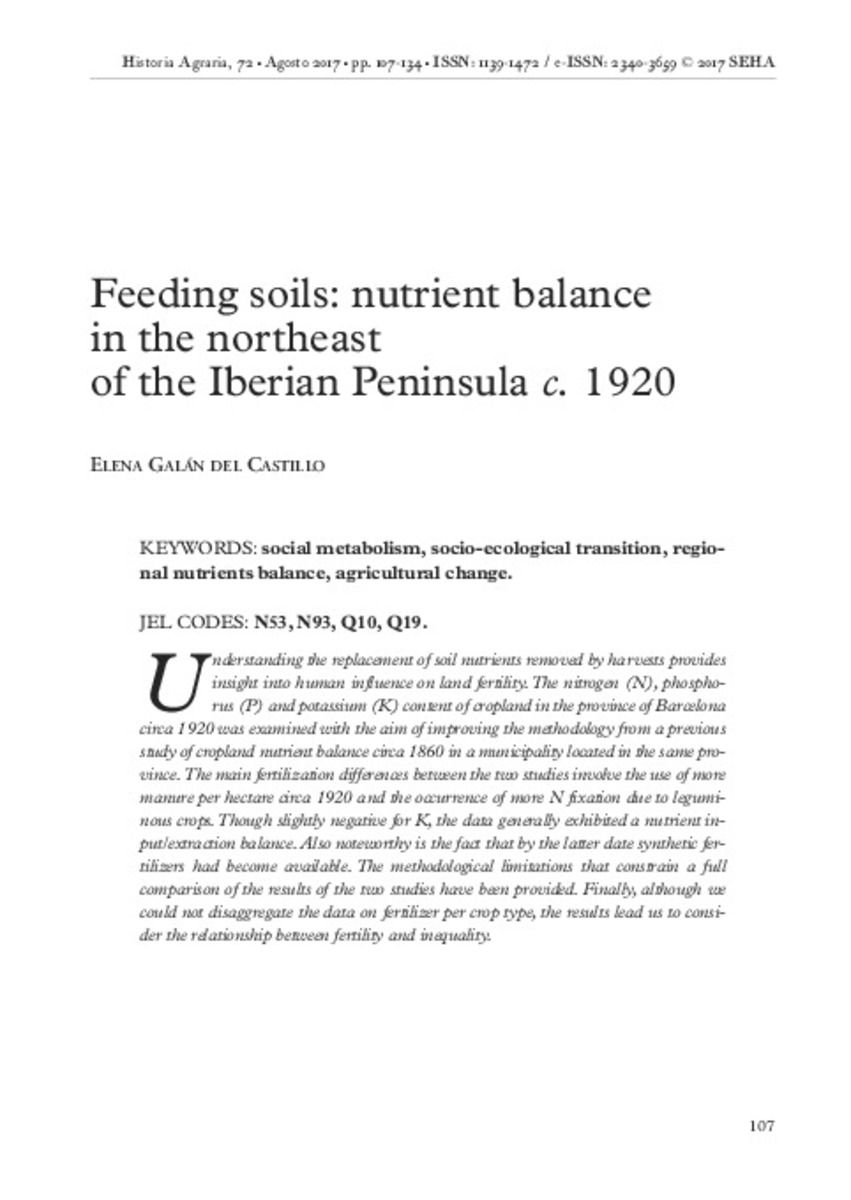Mostrar el registro sencillo del ítem
Feeding soils: nutrient balance in the northeast of the Iberian Peninsula c. 1920
| dc.contributor.author | Galán del Castillo, Elena | |
| dc.date.accessioned | 2018-03-04T09:07:59Z | |
| dc.date.available | 2018-03-04T09:07:59Z | |
| dc.date.issued | 2017-08 | |
| dc.identifier.issn | 1139-1472 | |
| dc.identifier.uri | http://hdl.handle.net/10234/173184 | |
| dc.description.abstract | Understanding the replacement of soil nutrients removed by harvests provides insight into human influence on land fertility. The nitrogen (N), phosphorus (P) and potassium (K) content of cropland in the province of Barcelona circa 1920 was examined with the aim of improving the methodology from a previous study of cropland nutrient balance circa 1860 in a municipality located in the same province. The main fertilization differences between the two studies involve the use of more manure per hectare circa 1920 and the occurrence of more N fixation due to leguminous crops. Though slightly negative for K, the data generally exhibited a nutrient input/ extraction balance. Also noteworthy is the fact that by the latter date synthetic fertilizers had become available. The methodological limitations that constrain a full comparison of the results of the two studies have been provided. Finally, although we could not disaggregate the data on fertilizer per crop type, the results lead us to consider the relationship between fertility and inequality. | ca_CA |
| dc.description.abstract | Comprender la sustitución de los nutrientes extraídos por las cosechas nos ayuda a entender la influencia de los seres humanos sobre la fertilidad. Hemos hecho un balance de N, P y K en tierras de cultivo de alrededor de 1920 de la provincia de Barcelona. El objetivo era mejorar la metodología de un estudio previo sobre el equilibrio de nutrientes de la superficie de tierra agrícola en un municipio situado en la provincia de Barcelona alrededor de 1860. También se han incluido las limitaciones metodológicas que restringen la comparación de los resultados de ambos estudios. La principal diferencia en cuanto a fertilización entre los dos balances es que aproximadamente en 1920 aparecen los fertilizantes sintéticos y, además, hay más estiércol por hectárea y más fijación de N a través de las leguminosas sembradas que alrededor de 1860. El balance global indica que las extracciones de nutrientes estaban en equilibrio con las adiciones, aunque el balance es ligeramente negativo para el K. Por último, aunque no pudimos desagregar las entradas de fertilizante por tipo de cultivo, los resultados nos llevan a considerar la relación entre la fertilidad y la desigualdad | ca_CA |
| dc.format.extent | 27 p, | ca_CA |
| dc.format.mimetype | application/pdf | ca_CA |
| dc.language.iso | eng | ca_CA |
| dc.publisher | Sociedad Española de Historia Agraria (SEHA) | ca_CA |
| dc.relation.isPartOf | Historia agraria: Revista de agricultura e historia rural, nº 72, 107-134 | ca_CA |
| dc.rights | © 2017 SEHA | ca_CA |
| dc.rights | Attribution-NonCommercial-NoDerivatives 4.0 Internacional | * |
| dc.rights.uri | http://creativecommons.org/licenses/by-nc-nd/4.0/ | * |
| dc.subject | metabolismo social | ca_CA |
| dc.subject | transición socioecológica | ca_CA |
| dc.subject | balance regional de nutrientes | ca_CA |
| dc.subject | cambio agrario | ca_CA |
| dc.subject | social metabolism | ca_CA |
| dc.subject | socio-ecological transition | ca_CA |
| dc.subject | regional nutrients balance | ca_CA |
| dc.subject | agrarian change | ca_CA |
| dc.title | Feeding soils: nutrient balance in the northeast of the Iberian Peninsula c. 1920 | ca_CA |
| dc.type | info:eu-repo/semantics/article | ca_CA |
| dc.subject.jel | N53 | ca_CA |
| dc.subject.jel | N93 | ca_CA |
| dc.subject.jel | Q10 | ca_CA |
| dc.subject.jel | Q19 | ca_CA |
| dc.rights.accessRights | info:eu-repo/semantics/openAccess | ca_CA |
| dc.relation.publisherVersion | http://www.historiaagraria.com/numero.php?n=72 | ca_CA |








